Leadership and Management in Operations: A Toyota Case Study Report
VerifiedAdded on 2020/12/10
|12
|3854
|344
Report
AI Summary
This report delves into the concepts of leadership and management, providing a comparative analysis of their respective roles and characteristics. It explores how these roles apply in various situations, emphasizing planning, organizing, directing, staffing, and controlling within a business context. The report also examines different leadership theories and models, including situational leadership, systems leadership, and the contingency model, and their practical applications. A significant portion of the report is dedicated to analyzing Toyota's operations management, highlighting the key approaches, the roles of leaders and managers within Toyota's global business strategy, and the importance of operations management in achieving and sustaining the company's business objectives. Furthermore, it assesses the factors within Toyota's business environment that impact operational management and decision-making by leaders and managers, providing a comprehensive overview of leadership and management in a real-world business setting.
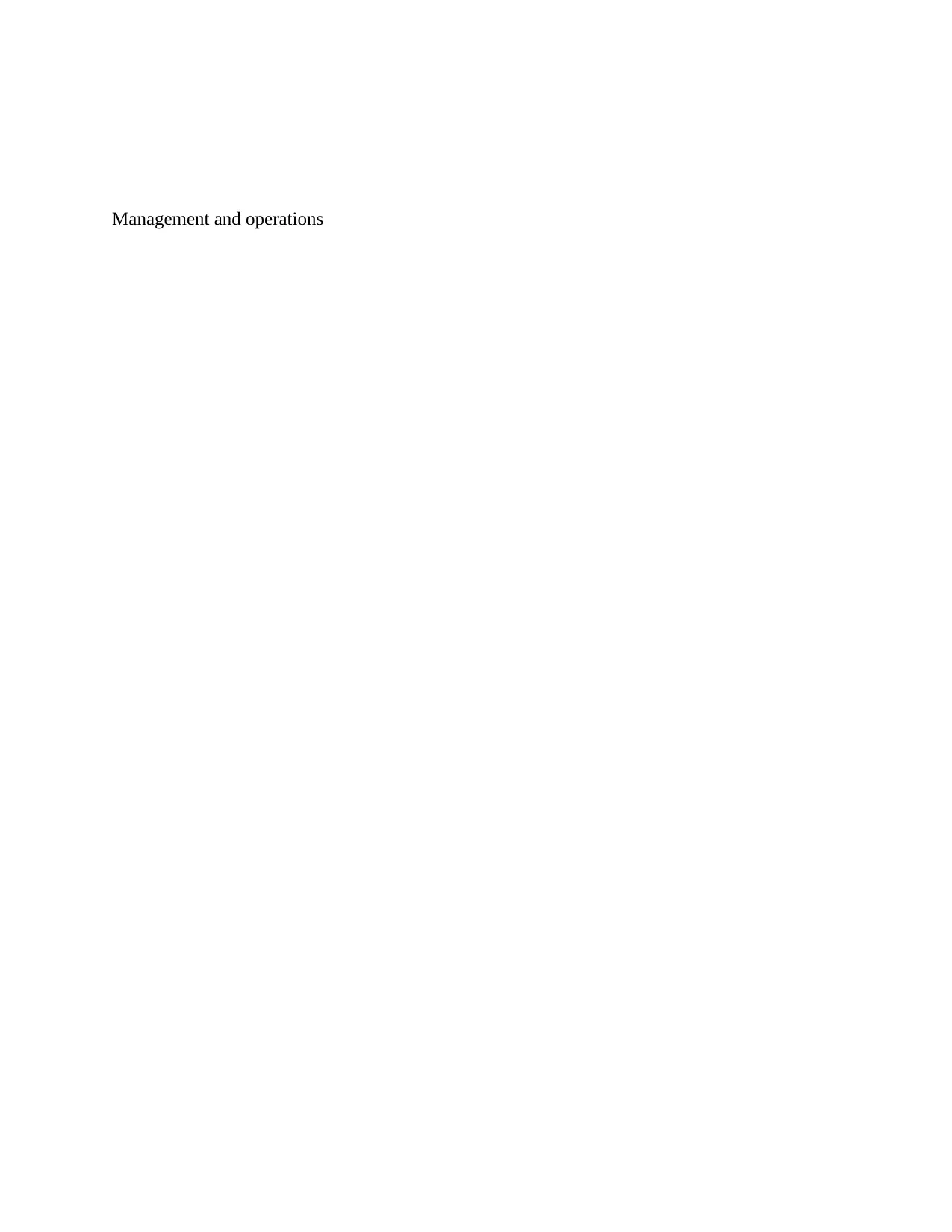
Management and operations
Paraphrase This Document
Need a fresh take? Get an instant paraphrase of this document with our AI Paraphraser

Table of Contents
Introduction.................................................................................................................................................3
LO1.............................................................................................................................................................3
P1 Define and compare different roles and characteristics of leader and manager..................................3
LO2.............................................................................................................................................................5
P2 Examine examples of how role of leader and function of manager apply in different situations........5
P3 Apply different theories and models of approach including situational leadership, systems
leadership and contingency......................................................................................................................6
LO3.............................................................................................................................................................7
P4 Explain the key approaches to operations management and the role that leaders and managers play
in Toyota global business strategy...........................................................................................................7
Varied approaches to operations management are used by Toyota PLC which are as follows;...............7
LO4.............................................................................................................................................................8
P5 Explain the importance and value of operations management in achieving and sustaining Toyota’s
business objectives..................................................................................................................................8
P6 Access the factors within Toyota business environment that can impact upon operational
management and decision making by leaders and managers...................................................................9
Conclusion...................................................................................................................................................9
References..............................................................................................................................................11
Introduction.................................................................................................................................................3
LO1.............................................................................................................................................................3
P1 Define and compare different roles and characteristics of leader and manager..................................3
LO2.............................................................................................................................................................5
P2 Examine examples of how role of leader and function of manager apply in different situations........5
P3 Apply different theories and models of approach including situational leadership, systems
leadership and contingency......................................................................................................................6
LO3.............................................................................................................................................................7
P4 Explain the key approaches to operations management and the role that leaders and managers play
in Toyota global business strategy...........................................................................................................7
Varied approaches to operations management are used by Toyota PLC which are as follows;...............7
LO4.............................................................................................................................................................8
P5 Explain the importance and value of operations management in achieving and sustaining Toyota’s
business objectives..................................................................................................................................8
P6 Access the factors within Toyota business environment that can impact upon operational
management and decision making by leaders and managers...................................................................9
Conclusion...................................................................................................................................................9
References..............................................................................................................................................11
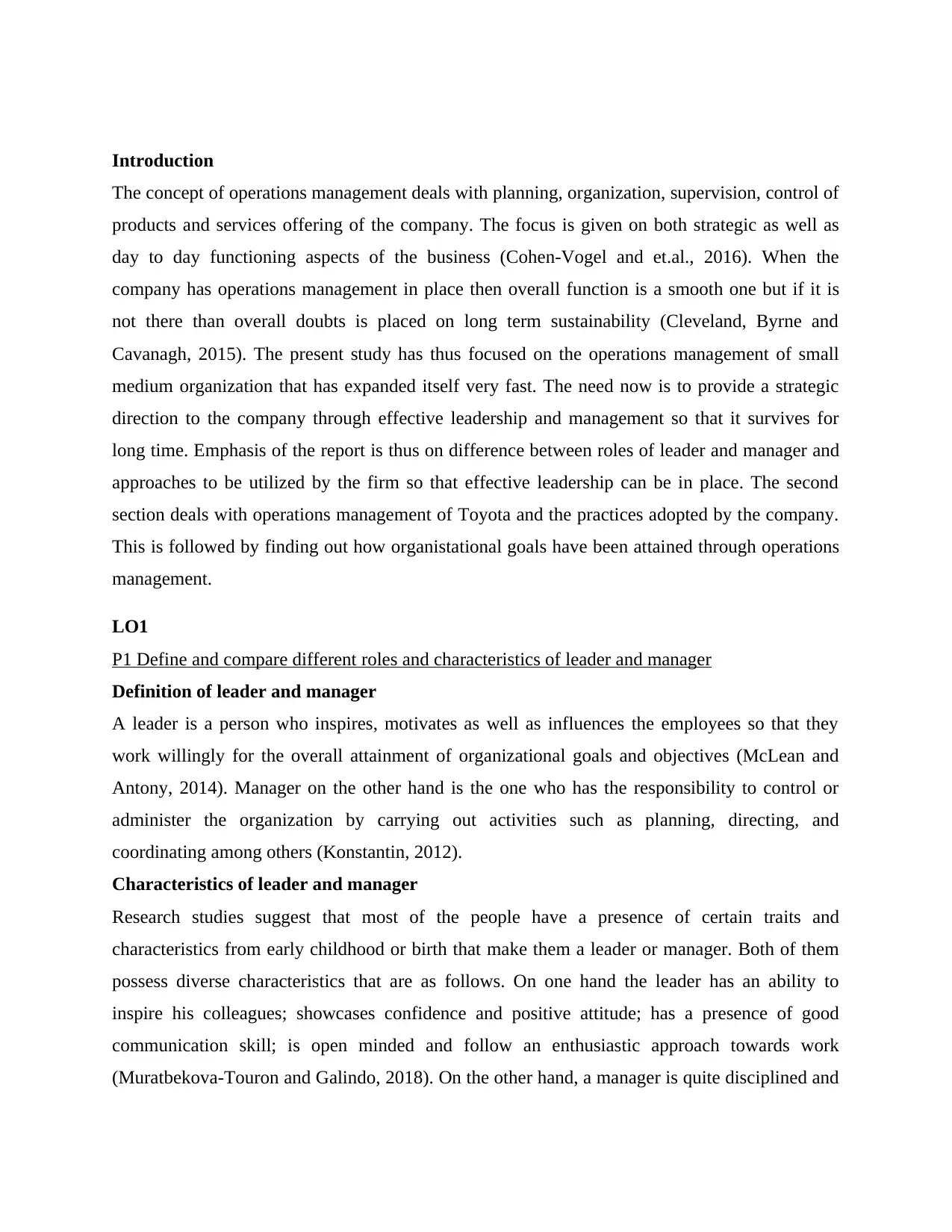
Introduction
The concept of operations management deals with planning, organization, supervision, control of
products and services offering of the company. The focus is given on both strategic as well as
day to day functioning aspects of the business (Cohen-Vogel and et.al., 2016). When the
company has operations management in place then overall function is a smooth one but if it is
not there than overall doubts is placed on long term sustainability (Cleveland, Byrne and
Cavanagh, 2015). The present study has thus focused on the operations management of small
medium organization that has expanded itself very fast. The need now is to provide a strategic
direction to the company through effective leadership and management so that it survives for
long time. Emphasis of the report is thus on difference between roles of leader and manager and
approaches to be utilized by the firm so that effective leadership can be in place. The second
section deals with operations management of Toyota and the practices adopted by the company.
This is followed by finding out how organistational goals have been attained through operations
management.
LO1
P1 Define and compare different roles and characteristics of leader and manager
Definition of leader and manager
A leader is a person who inspires, motivates as well as influences the employees so that they
work willingly for the overall attainment of organizational goals and objectives (McLean and
Antony, 2014). Manager on the other hand is the one who has the responsibility to control or
administer the organization by carrying out activities such as planning, directing, and
coordinating among others (Konstantin, 2012).
Characteristics of leader and manager
Research studies suggest that most of the people have a presence of certain traits and
characteristics from early childhood or birth that make them a leader or manager. Both of them
possess diverse characteristics that are as follows. On one hand the leader has an ability to
inspire his colleagues; showcases confidence and positive attitude; has a presence of good
communication skill; is open minded and follow an enthusiastic approach towards work
(Muratbekova-Touron and Galindo, 2018). On the other hand, a manager is quite disciplined and
The concept of operations management deals with planning, organization, supervision, control of
products and services offering of the company. The focus is given on both strategic as well as
day to day functioning aspects of the business (Cohen-Vogel and et.al., 2016). When the
company has operations management in place then overall function is a smooth one but if it is
not there than overall doubts is placed on long term sustainability (Cleveland, Byrne and
Cavanagh, 2015). The present study has thus focused on the operations management of small
medium organization that has expanded itself very fast. The need now is to provide a strategic
direction to the company through effective leadership and management so that it survives for
long time. Emphasis of the report is thus on difference between roles of leader and manager and
approaches to be utilized by the firm so that effective leadership can be in place. The second
section deals with operations management of Toyota and the practices adopted by the company.
This is followed by finding out how organistational goals have been attained through operations
management.
LO1
P1 Define and compare different roles and characteristics of leader and manager
Definition of leader and manager
A leader is a person who inspires, motivates as well as influences the employees so that they
work willingly for the overall attainment of organizational goals and objectives (McLean and
Antony, 2014). Manager on the other hand is the one who has the responsibility to control or
administer the organization by carrying out activities such as planning, directing, and
coordinating among others (Konstantin, 2012).
Characteristics of leader and manager
Research studies suggest that most of the people have a presence of certain traits and
characteristics from early childhood or birth that make them a leader or manager. Both of them
possess diverse characteristics that are as follows. On one hand the leader has an ability to
inspire his colleagues; showcases confidence and positive attitude; has a presence of good
communication skill; is open minded and follow an enthusiastic approach towards work
(Muratbekova-Touron and Galindo, 2018). On the other hand, a manager is quite disciplined and
⊘ This is a preview!⊘
Do you want full access?
Subscribe today to unlock all pages.

Trusted by 1+ million students worldwide
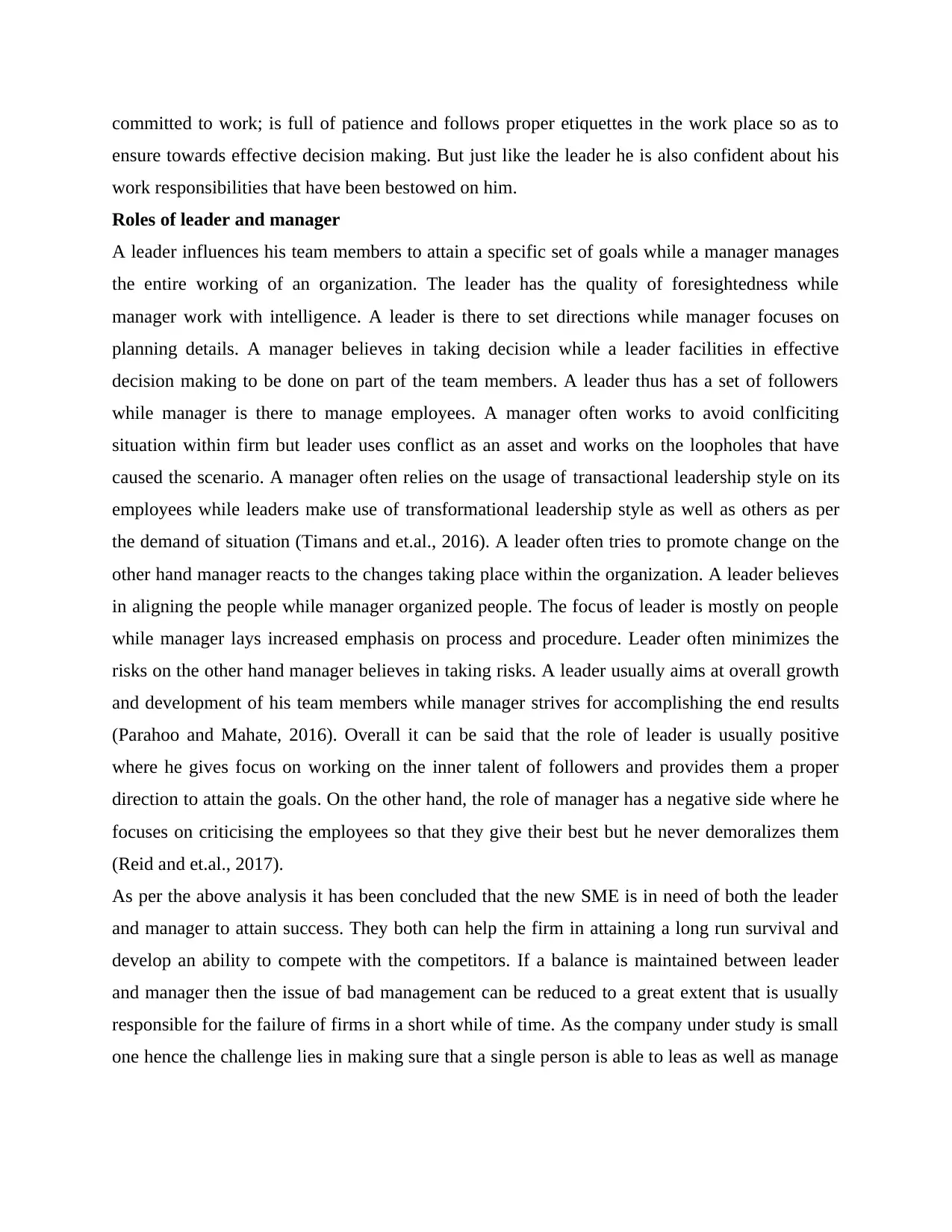
committed to work; is full of patience and follows proper etiquettes in the work place so as to
ensure towards effective decision making. But just like the leader he is also confident about his
work responsibilities that have been bestowed on him.
Roles of leader and manager
A leader influences his team members to attain a specific set of goals while a manager manages
the entire working of an organization. The leader has the quality of foresightedness while
manager work with intelligence. A leader is there to set directions while manager focuses on
planning details. A manager believes in taking decision while a leader facilities in effective
decision making to be done on part of the team members. A leader thus has a set of followers
while manager is there to manage employees. A manager often works to avoid conlficiting
situation within firm but leader uses conflict as an asset and works on the loopholes that have
caused the scenario. A manager often relies on the usage of transactional leadership style on its
employees while leaders make use of transformational leadership style as well as others as per
the demand of situation (Timans and et.al., 2016). A leader often tries to promote change on the
other hand manager reacts to the changes taking place within the organization. A leader believes
in aligning the people while manager organized people. The focus of leader is mostly on people
while manager lays increased emphasis on process and procedure. Leader often minimizes the
risks on the other hand manager believes in taking risks. A leader usually aims at overall growth
and development of his team members while manager strives for accomplishing the end results
(Parahoo and Mahate, 2016). Overall it can be said that the role of leader is usually positive
where he gives focus on working on the inner talent of followers and provides them a proper
direction to attain the goals. On the other hand, the role of manager has a negative side where he
focuses on criticising the employees so that they give their best but he never demoralizes them
(Reid and et.al., 2017).
As per the above analysis it has been concluded that the new SME is in need of both the leader
and manager to attain success. They both can help the firm in attaining a long run survival and
develop an ability to compete with the competitors. If a balance is maintained between leader
and manager then the issue of bad management can be reduced to a great extent that is usually
responsible for the failure of firms in a short while of time. As the company under study is small
one hence the challenge lies in making sure that a single person is able to leas as well as manage
ensure towards effective decision making. But just like the leader he is also confident about his
work responsibilities that have been bestowed on him.
Roles of leader and manager
A leader influences his team members to attain a specific set of goals while a manager manages
the entire working of an organization. The leader has the quality of foresightedness while
manager work with intelligence. A leader is there to set directions while manager focuses on
planning details. A manager believes in taking decision while a leader facilities in effective
decision making to be done on part of the team members. A leader thus has a set of followers
while manager is there to manage employees. A manager often works to avoid conlficiting
situation within firm but leader uses conflict as an asset and works on the loopholes that have
caused the scenario. A manager often relies on the usage of transactional leadership style on its
employees while leaders make use of transformational leadership style as well as others as per
the demand of situation (Timans and et.al., 2016). A leader often tries to promote change on the
other hand manager reacts to the changes taking place within the organization. A leader believes
in aligning the people while manager organized people. The focus of leader is mostly on people
while manager lays increased emphasis on process and procedure. Leader often minimizes the
risks on the other hand manager believes in taking risks. A leader usually aims at overall growth
and development of his team members while manager strives for accomplishing the end results
(Parahoo and Mahate, 2016). Overall it can be said that the role of leader is usually positive
where he gives focus on working on the inner talent of followers and provides them a proper
direction to attain the goals. On the other hand, the role of manager has a negative side where he
focuses on criticising the employees so that they give their best but he never demoralizes them
(Reid and et.al., 2017).
As per the above analysis it has been concluded that the new SME is in need of both the leader
and manager to attain success. They both can help the firm in attaining a long run survival and
develop an ability to compete with the competitors. If a balance is maintained between leader
and manager then the issue of bad management can be reduced to a great extent that is usually
responsible for the failure of firms in a short while of time. As the company under study is small
one hence the challenge lies in making sure that a single person is able to leas as well as manage
Paraphrase This Document
Need a fresh take? Get an instant paraphrase of this document with our AI Paraphraser
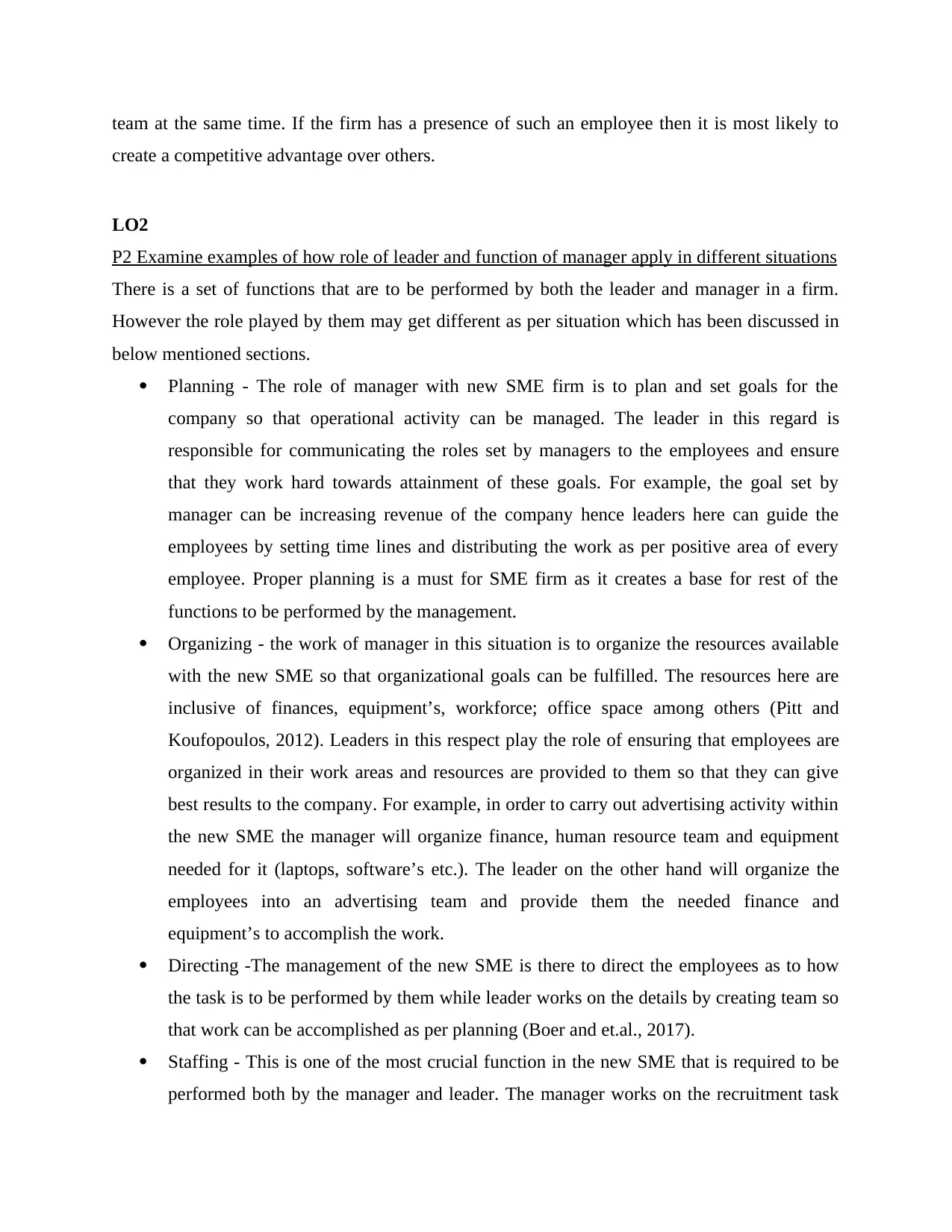
team at the same time. If the firm has a presence of such an employee then it is most likely to
create a competitive advantage over others.
LO2
P2 Examine examples of how role of leader and function of manager apply in different situations
There is a set of functions that are to be performed by both the leader and manager in a firm.
However the role played by them may get different as per situation which has been discussed in
below mentioned sections.
Planning - The role of manager with new SME firm is to plan and set goals for the
company so that operational activity can be managed. The leader in this regard is
responsible for communicating the roles set by managers to the employees and ensure
that they work hard towards attainment of these goals. For example, the goal set by
manager can be increasing revenue of the company hence leaders here can guide the
employees by setting time lines and distributing the work as per positive area of every
employee. Proper planning is a must for SME firm as it creates a base for rest of the
functions to be performed by the management.
Organizing - the work of manager in this situation is to organize the resources available
with the new SME so that organizational goals can be fulfilled. The resources here are
inclusive of finances, equipment’s, workforce; office space among others (Pitt and
Koufopoulos, 2012). Leaders in this respect play the role of ensuring that employees are
organized in their work areas and resources are provided to them so that they can give
best results to the company. For example, in order to carry out advertising activity within
the new SME the manager will organize finance, human resource team and equipment
needed for it (laptops, software’s etc.). The leader on the other hand will organize the
employees into an advertising team and provide them the needed finance and
equipment’s to accomplish the work.
Directing -The management of the new SME is there to direct the employees as to how
the task is to be performed by them while leader works on the details by creating team so
that work can be accomplished as per planning (Boer and et.al., 2017).
Staffing - This is one of the most crucial function in the new SME that is required to be
performed both by the manager and leader. The manager works on the recruitment task
create a competitive advantage over others.
LO2
P2 Examine examples of how role of leader and function of manager apply in different situations
There is a set of functions that are to be performed by both the leader and manager in a firm.
However the role played by them may get different as per situation which has been discussed in
below mentioned sections.
Planning - The role of manager with new SME firm is to plan and set goals for the
company so that operational activity can be managed. The leader in this regard is
responsible for communicating the roles set by managers to the employees and ensure
that they work hard towards attainment of these goals. For example, the goal set by
manager can be increasing revenue of the company hence leaders here can guide the
employees by setting time lines and distributing the work as per positive area of every
employee. Proper planning is a must for SME firm as it creates a base for rest of the
functions to be performed by the management.
Organizing - the work of manager in this situation is to organize the resources available
with the new SME so that organizational goals can be fulfilled. The resources here are
inclusive of finances, equipment’s, workforce; office space among others (Pitt and
Koufopoulos, 2012). Leaders in this respect play the role of ensuring that employees are
organized in their work areas and resources are provided to them so that they can give
best results to the company. For example, in order to carry out advertising activity within
the new SME the manager will organize finance, human resource team and equipment
needed for it (laptops, software’s etc.). The leader on the other hand will organize the
employees into an advertising team and provide them the needed finance and
equipment’s to accomplish the work.
Directing -The management of the new SME is there to direct the employees as to how
the task is to be performed by them while leader works on the details by creating team so
that work can be accomplished as per planning (Boer and et.al., 2017).
Staffing - This is one of the most crucial function in the new SME that is required to be
performed both by the manager and leader. The manager works on the recruitment task

and assigns job to employees as per skills and capabilities (Consiglio and et.al., 2013).
The leader on the other hand will focus on motivating the employees and allocating them
work as per their abilities. A two way communication will also be maintained by the
leader and grievances will also be solved followed by carrying out overall performance
evaluation.
Controlling: the strategies that have been made by managers as well as those that are
implemented by the leaders in the new SME are required to be monitored by the
management of the company. The work of leader here is to verify the overall outcome of
performance rendered by employees with respect to the standards that has been laid by
managers. The leaders further have a role to guide the employees accordingly
(Tannenbaum and Cerasoli, 2013).
P3 Apply different theories and models of approach including situational leadership, systems
leadership and contingency
Situational leadership theory
As the company is a new one hence there is a need to form a strong employee base which can
only be done if leadership is up to the mark. Hence there can be an application of various
theories and models of approach so that employees can be led in best possible manner. One such
is situational theory wherein the leader is required to modify the leadership style so as to fit the
followers which are to be influenced within the company (Muratbekova-Touron and Galindo,
2018). For example, as the company is a new one and has a set of very less employees in terms
of number hence there will be increased work responsibilities on the members in case some of
them go on a leave. Telling and directing style of leadership can thus be applied by the leader in
these situations. This will involve for close supervision by the management and adoption of top-
down approach of communication. The strategy is most likely to ensure towards fast flow of
work and creation of least possible mistakes by the employees. Selling and coaching style can
however be adopted with new employees who are not aware about the office culture as well as
work responsibilities. This will help them attain a comfort level due to involvement of leader in
there day to day activities.
System leadership theory
There can further be an application of system leadership theory by the management team at the
new SME firm. This will be all about creating conditions for the leaders where the employees at
The leader on the other hand will focus on motivating the employees and allocating them
work as per their abilities. A two way communication will also be maintained by the
leader and grievances will also be solved followed by carrying out overall performance
evaluation.
Controlling: the strategies that have been made by managers as well as those that are
implemented by the leaders in the new SME are required to be monitored by the
management of the company. The work of leader here is to verify the overall outcome of
performance rendered by employees with respect to the standards that has been laid by
managers. The leaders further have a role to guide the employees accordingly
(Tannenbaum and Cerasoli, 2013).
P3 Apply different theories and models of approach including situational leadership, systems
leadership and contingency
Situational leadership theory
As the company is a new one hence there is a need to form a strong employee base which can
only be done if leadership is up to the mark. Hence there can be an application of various
theories and models of approach so that employees can be led in best possible manner. One such
is situational theory wherein the leader is required to modify the leadership style so as to fit the
followers which are to be influenced within the company (Muratbekova-Touron and Galindo,
2018). For example, as the company is a new one and has a set of very less employees in terms
of number hence there will be increased work responsibilities on the members in case some of
them go on a leave. Telling and directing style of leadership can thus be applied by the leader in
these situations. This will involve for close supervision by the management and adoption of top-
down approach of communication. The strategy is most likely to ensure towards fast flow of
work and creation of least possible mistakes by the employees. Selling and coaching style can
however be adopted with new employees who are not aware about the office culture as well as
work responsibilities. This will help them attain a comfort level due to involvement of leader in
there day to day activities.
System leadership theory
There can further be an application of system leadership theory by the management team at the
new SME firm. This will be all about creating conditions for the leaders where the employees at
⊘ This is a preview!⊘
Do you want full access?
Subscribe today to unlock all pages.

Trusted by 1+ million students worldwide
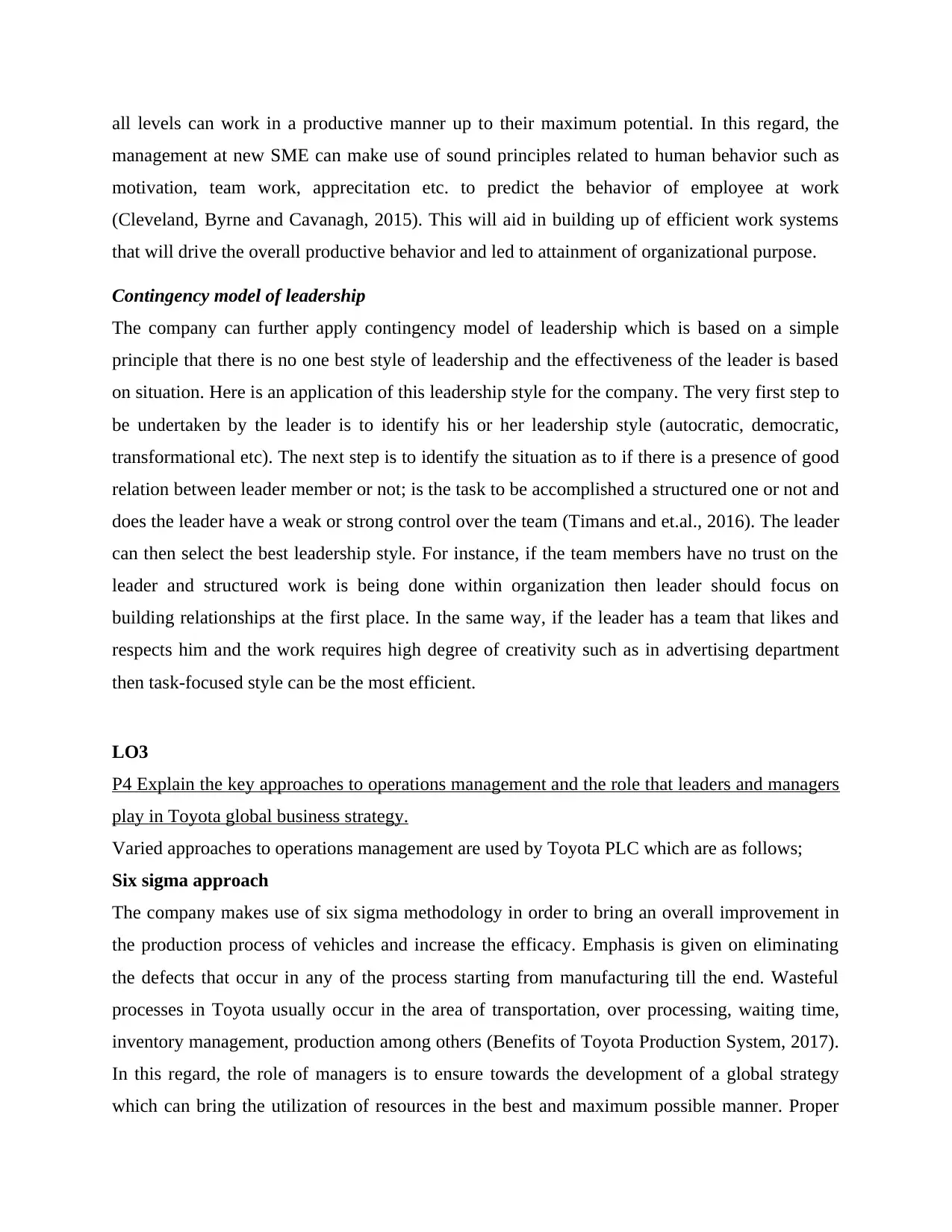
all levels can work in a productive manner up to their maximum potential. In this regard, the
management at new SME can make use of sound principles related to human behavior such as
motivation, team work, apprecitation etc. to predict the behavior of employee at work
(Cleveland, Byrne and Cavanagh, 2015). This will aid in building up of efficient work systems
that will drive the overall productive behavior and led to attainment of organizational purpose.
Contingency model of leadership
The company can further apply contingency model of leadership which is based on a simple
principle that there is no one best style of leadership and the effectiveness of the leader is based
on situation. Here is an application of this leadership style for the company. The very first step to
be undertaken by the leader is to identify his or her leadership style (autocratic, democratic,
transformational etc). The next step is to identify the situation as to if there is a presence of good
relation between leader member or not; is the task to be accomplished a structured one or not and
does the leader have a weak or strong control over the team (Timans and et.al., 2016). The leader
can then select the best leadership style. For instance, if the team members have no trust on the
leader and structured work is being done within organization then leader should focus on
building relationships at the first place. In the same way, if the leader has a team that likes and
respects him and the work requires high degree of creativity such as in advertising department
then task-focused style can be the most efficient.
LO3
P4 Explain the key approaches to operations management and the role that leaders and managers
play in Toyota global business strategy.
Varied approaches to operations management are used by Toyota PLC which are as follows;
Six sigma approach
The company makes use of six sigma methodology in order to bring an overall improvement in
the production process of vehicles and increase the efficacy. Emphasis is given on eliminating
the defects that occur in any of the process starting from manufacturing till the end. Wasteful
processes in Toyota usually occur in the area of transportation, over processing, waiting time,
inventory management, production among others (Benefits of Toyota Production System, 2017).
In this regard, the role of managers is to ensure towards the development of a global strategy
which can bring the utilization of resources in the best and maximum possible manner. Proper
management at new SME can make use of sound principles related to human behavior such as
motivation, team work, apprecitation etc. to predict the behavior of employee at work
(Cleveland, Byrne and Cavanagh, 2015). This will aid in building up of efficient work systems
that will drive the overall productive behavior and led to attainment of organizational purpose.
Contingency model of leadership
The company can further apply contingency model of leadership which is based on a simple
principle that there is no one best style of leadership and the effectiveness of the leader is based
on situation. Here is an application of this leadership style for the company. The very first step to
be undertaken by the leader is to identify his or her leadership style (autocratic, democratic,
transformational etc). The next step is to identify the situation as to if there is a presence of good
relation between leader member or not; is the task to be accomplished a structured one or not and
does the leader have a weak or strong control over the team (Timans and et.al., 2016). The leader
can then select the best leadership style. For instance, if the team members have no trust on the
leader and structured work is being done within organization then leader should focus on
building relationships at the first place. In the same way, if the leader has a team that likes and
respects him and the work requires high degree of creativity such as in advertising department
then task-focused style can be the most efficient.
LO3
P4 Explain the key approaches to operations management and the role that leaders and managers
play in Toyota global business strategy.
Varied approaches to operations management are used by Toyota PLC which are as follows;
Six sigma approach
The company makes use of six sigma methodology in order to bring an overall improvement in
the production process of vehicles and increase the efficacy. Emphasis is given on eliminating
the defects that occur in any of the process starting from manufacturing till the end. Wasteful
processes in Toyota usually occur in the area of transportation, over processing, waiting time,
inventory management, production among others (Benefits of Toyota Production System, 2017).
In this regard, the role of managers is to ensure towards the development of a global strategy
which can bring the utilization of resources in the best and maximum possible manner. Proper
Paraphrase This Document
Need a fresh take? Get an instant paraphrase of this document with our AI Paraphraser
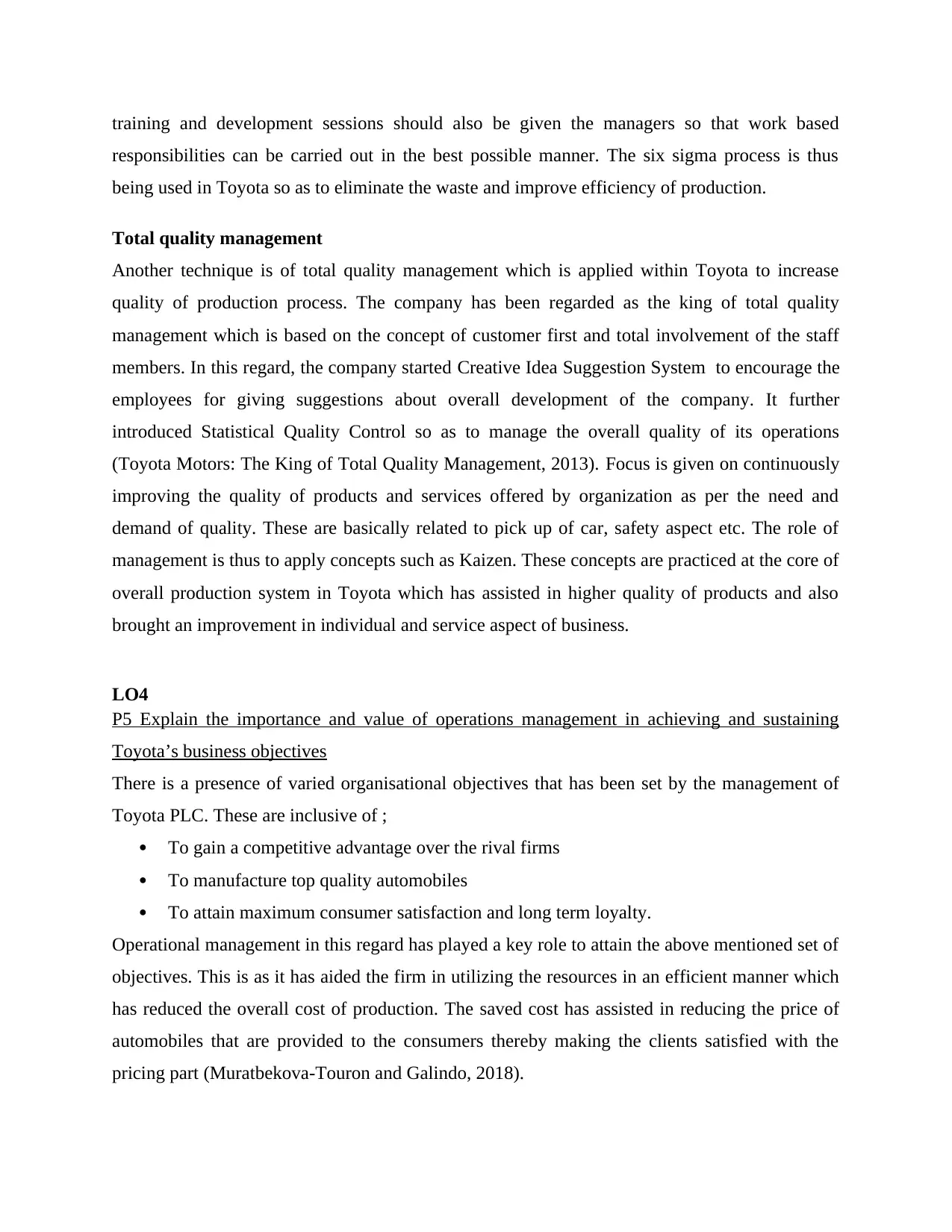
training and development sessions should also be given the managers so that work based
responsibilities can be carried out in the best possible manner. The six sigma process is thus
being used in Toyota so as to eliminate the waste and improve efficiency of production.
Total quality management
Another technique is of total quality management which is applied within Toyota to increase
quality of production process. The company has been regarded as the king of total quality
management which is based on the concept of customer first and total involvement of the staff
members. In this regard, the company started Creative Idea Suggestion System to encourage the
employees for giving suggestions about overall development of the company. It further
introduced Statistical Quality Control so as to manage the overall quality of its operations
(Toyota Motors: The King of Total Quality Management, 2013). Focus is given on continuously
improving the quality of products and services offered by organization as per the need and
demand of quality. These are basically related to pick up of car, safety aspect etc. The role of
management is thus to apply concepts such as Kaizen. These concepts are practiced at the core of
overall production system in Toyota which has assisted in higher quality of products and also
brought an improvement in individual and service aspect of business.
LO4
P5 Explain the importance and value of operations management in achieving and sustaining
Toyota’s business objectives
There is a presence of varied organisational objectives that has been set by the management of
Toyota PLC. These are inclusive of ;
To gain a competitive advantage over the rival firms
To manufacture top quality automobiles
To attain maximum consumer satisfaction and long term loyalty.
Operational management in this regard has played a key role to attain the above mentioned set of
objectives. This is as it has aided the firm in utilizing the resources in an efficient manner which
has reduced the overall cost of production. The saved cost has assisted in reducing the price of
automobiles that are provided to the consumers thereby making the clients satisfied with the
pricing part (Muratbekova-Touron and Galindo, 2018).
responsibilities can be carried out in the best possible manner. The six sigma process is thus
being used in Toyota so as to eliminate the waste and improve efficiency of production.
Total quality management
Another technique is of total quality management which is applied within Toyota to increase
quality of production process. The company has been regarded as the king of total quality
management which is based on the concept of customer first and total involvement of the staff
members. In this regard, the company started Creative Idea Suggestion System to encourage the
employees for giving suggestions about overall development of the company. It further
introduced Statistical Quality Control so as to manage the overall quality of its operations
(Toyota Motors: The King of Total Quality Management, 2013). Focus is given on continuously
improving the quality of products and services offered by organization as per the need and
demand of quality. These are basically related to pick up of car, safety aspect etc. The role of
management is thus to apply concepts such as Kaizen. These concepts are practiced at the core of
overall production system in Toyota which has assisted in higher quality of products and also
brought an improvement in individual and service aspect of business.
LO4
P5 Explain the importance and value of operations management in achieving and sustaining
Toyota’s business objectives
There is a presence of varied organisational objectives that has been set by the management of
Toyota PLC. These are inclusive of ;
To gain a competitive advantage over the rival firms
To manufacture top quality automobiles
To attain maximum consumer satisfaction and long term loyalty.
Operational management in this regard has played a key role to attain the above mentioned set of
objectives. This is as it has aided the firm in utilizing the resources in an efficient manner which
has reduced the overall cost of production. The saved cost has assisted in reducing the price of
automobiles that are provided to the consumers thereby making the clients satisfied with the
pricing part (Muratbekova-Touron and Galindo, 2018).
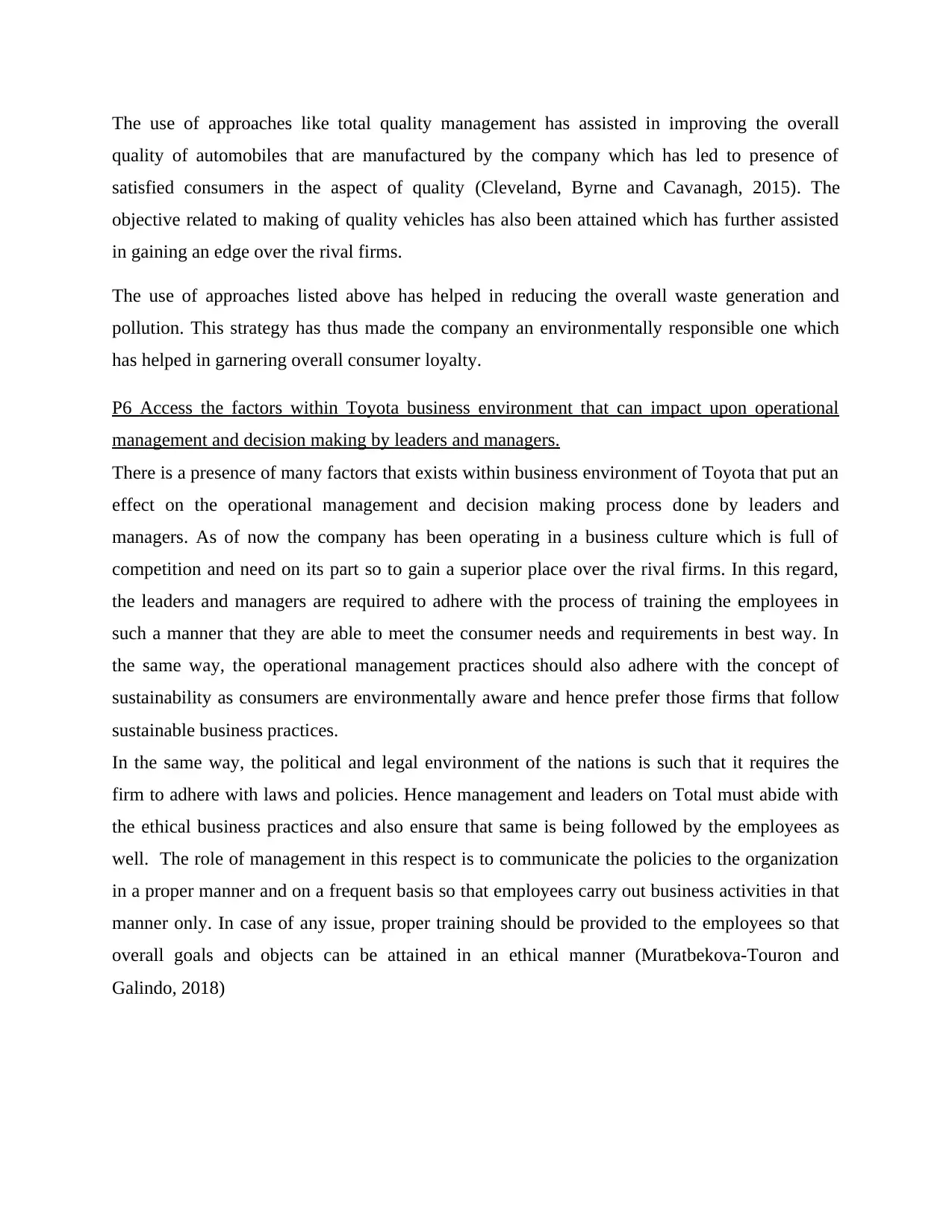
The use of approaches like total quality management has assisted in improving the overall
quality of automobiles that are manufactured by the company which has led to presence of
satisfied consumers in the aspect of quality (Cleveland, Byrne and Cavanagh, 2015). The
objective related to making of quality vehicles has also been attained which has further assisted
in gaining an edge over the rival firms.
The use of approaches listed above has helped in reducing the overall waste generation and
pollution. This strategy has thus made the company an environmentally responsible one which
has helped in garnering overall consumer loyalty.
P6 Access the factors within Toyota business environment that can impact upon operational
management and decision making by leaders and managers.
There is a presence of many factors that exists within business environment of Toyota that put an
effect on the operational management and decision making process done by leaders and
managers. As of now the company has been operating in a business culture which is full of
competition and need on its part so to gain a superior place over the rival firms. In this regard,
the leaders and managers are required to adhere with the process of training the employees in
such a manner that they are able to meet the consumer needs and requirements in best way. In
the same way, the operational management practices should also adhere with the concept of
sustainability as consumers are environmentally aware and hence prefer those firms that follow
sustainable business practices.
In the same way, the political and legal environment of the nations is such that it requires the
firm to adhere with laws and policies. Hence management and leaders on Total must abide with
the ethical business practices and also ensure that same is being followed by the employees as
well. The role of management in this respect is to communicate the policies to the organization
in a proper manner and on a frequent basis so that employees carry out business activities in that
manner only. In case of any issue, proper training should be provided to the employees so that
overall goals and objects can be attained in an ethical manner (Muratbekova-Touron and
Galindo, 2018)
quality of automobiles that are manufactured by the company which has led to presence of
satisfied consumers in the aspect of quality (Cleveland, Byrne and Cavanagh, 2015). The
objective related to making of quality vehicles has also been attained which has further assisted
in gaining an edge over the rival firms.
The use of approaches listed above has helped in reducing the overall waste generation and
pollution. This strategy has thus made the company an environmentally responsible one which
has helped in garnering overall consumer loyalty.
P6 Access the factors within Toyota business environment that can impact upon operational
management and decision making by leaders and managers.
There is a presence of many factors that exists within business environment of Toyota that put an
effect on the operational management and decision making process done by leaders and
managers. As of now the company has been operating in a business culture which is full of
competition and need on its part so to gain a superior place over the rival firms. In this regard,
the leaders and managers are required to adhere with the process of training the employees in
such a manner that they are able to meet the consumer needs and requirements in best way. In
the same way, the operational management practices should also adhere with the concept of
sustainability as consumers are environmentally aware and hence prefer those firms that follow
sustainable business practices.
In the same way, the political and legal environment of the nations is such that it requires the
firm to adhere with laws and policies. Hence management and leaders on Total must abide with
the ethical business practices and also ensure that same is being followed by the employees as
well. The role of management in this respect is to communicate the policies to the organization
in a proper manner and on a frequent basis so that employees carry out business activities in that
manner only. In case of any issue, proper training should be provided to the employees so that
overall goals and objects can be attained in an ethical manner (Muratbekova-Touron and
Galindo, 2018)
⊘ This is a preview!⊘
Do you want full access?
Subscribe today to unlock all pages.

Trusted by 1+ million students worldwide
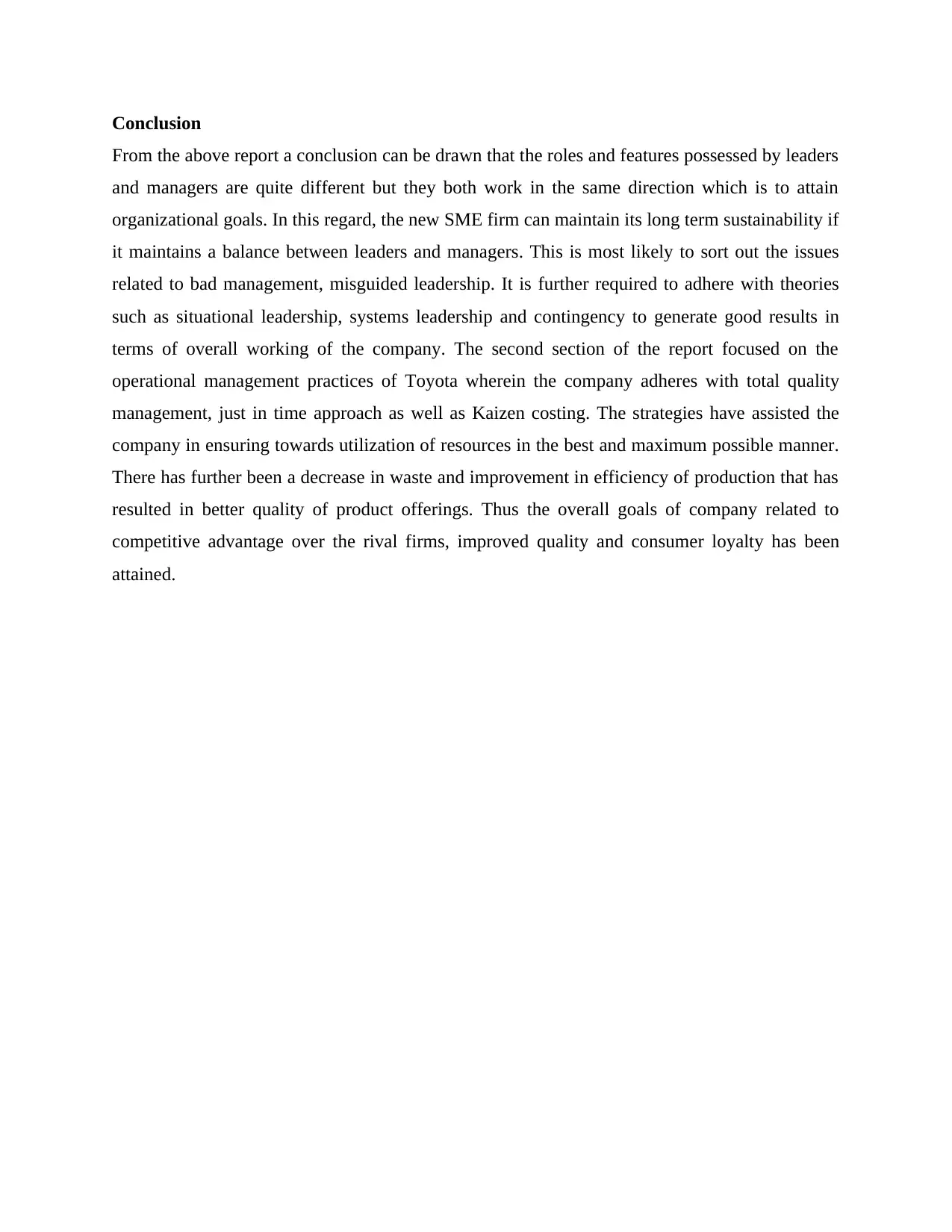
Conclusion
From the above report a conclusion can be drawn that the roles and features possessed by leaders
and managers are quite different but they both work in the same direction which is to attain
organizational goals. In this regard, the new SME firm can maintain its long term sustainability if
it maintains a balance between leaders and managers. This is most likely to sort out the issues
related to bad management, misguided leadership. It is further required to adhere with theories
such as situational leadership, systems leadership and contingency to generate good results in
terms of overall working of the company. The second section of the report focused on the
operational management practices of Toyota wherein the company adheres with total quality
management, just in time approach as well as Kaizen costing. The strategies have assisted the
company in ensuring towards utilization of resources in the best and maximum possible manner.
There has further been a decrease in waste and improvement in efficiency of production that has
resulted in better quality of product offerings. Thus the overall goals of company related to
competitive advantage over the rival firms, improved quality and consumer loyalty has been
attained.
From the above report a conclusion can be drawn that the roles and features possessed by leaders
and managers are quite different but they both work in the same direction which is to attain
organizational goals. In this regard, the new SME firm can maintain its long term sustainability if
it maintains a balance between leaders and managers. This is most likely to sort out the issues
related to bad management, misguided leadership. It is further required to adhere with theories
such as situational leadership, systems leadership and contingency to generate good results in
terms of overall working of the company. The second section of the report focused on the
operational management practices of Toyota wherein the company adheres with total quality
management, just in time approach as well as Kaizen costing. The strategies have assisted the
company in ensuring towards utilization of resources in the best and maximum possible manner.
There has further been a decrease in waste and improvement in efficiency of production that has
resulted in better quality of product offerings. Thus the overall goals of company related to
competitive advantage over the rival firms, improved quality and consumer loyalty has been
attained.
Paraphrase This Document
Need a fresh take? Get an instant paraphrase of this document with our AI Paraphraser
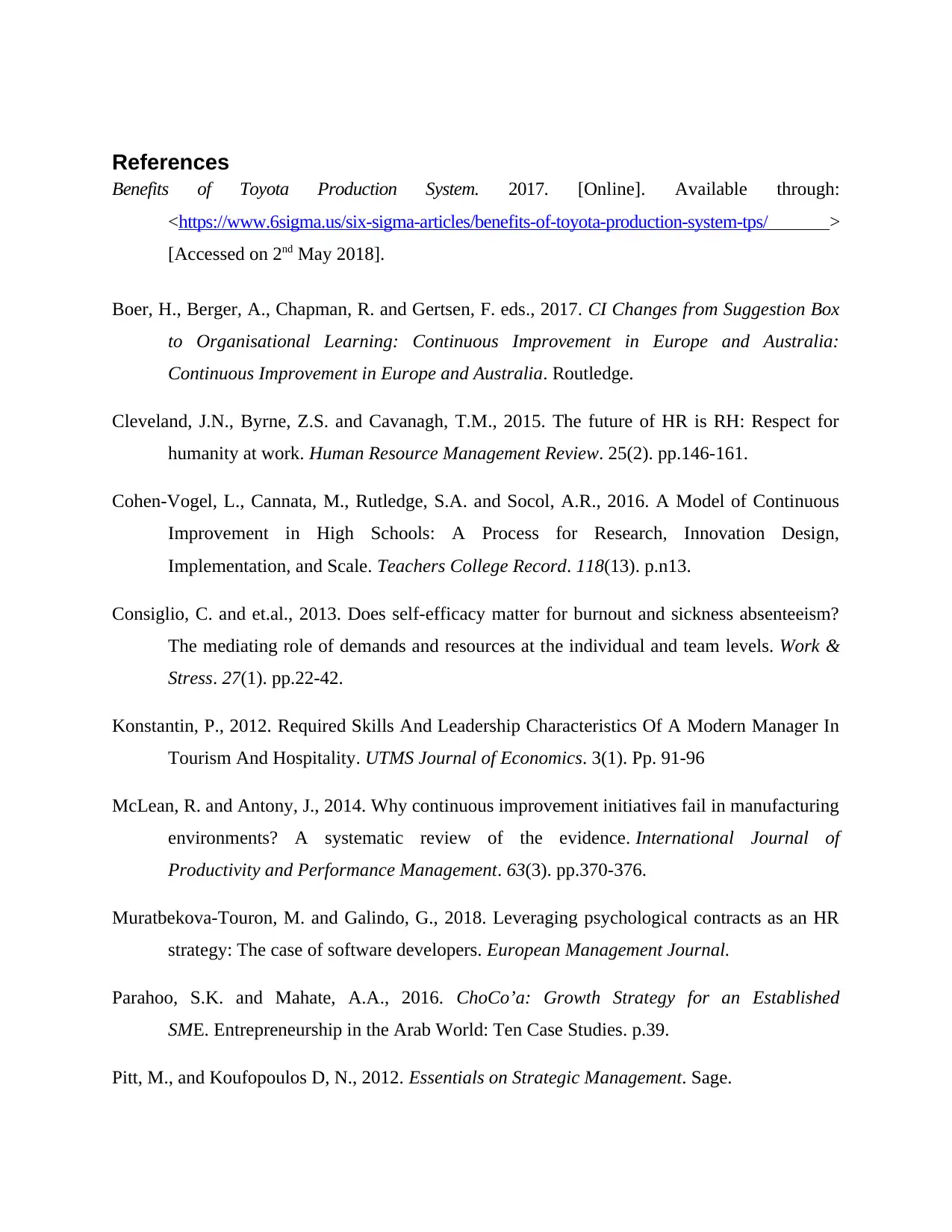
References
Benefits of Toyota Production System. 2017. [Online]. Available through:
<https://www.6sigma.us/six-sigma-articles/benefits-of-toyota-production-system-tps/ >
[Accessed on 2nd May 2018].
Boer, H., Berger, A., Chapman, R. and Gertsen, F. eds., 2017. CI Changes from Suggestion Box
to Organisational Learning: Continuous Improvement in Europe and Australia:
Continuous Improvement in Europe and Australia. Routledge.
Cleveland, J.N., Byrne, Z.S. and Cavanagh, T.M., 2015. The future of HR is RH: Respect for
humanity at work. Human Resource Management Review. 25(2). pp.146-161.
Cohen-Vogel, L., Cannata, M., Rutledge, S.A. and Socol, A.R., 2016. A Model of Continuous
Improvement in High Schools: A Process for Research, Innovation Design,
Implementation, and Scale. Teachers College Record. 118(13). p.n13.
Consiglio, C. and et.al., 2013. Does self-efficacy matter for burnout and sickness absenteeism?
The mediating role of demands and resources at the individual and team levels. Work &
Stress. 27(1). pp.22-42.
Konstantin, P., 2012. Required Skills And Leadership Characteristics Of A Modern Manager In
Tourism And Hospitality. UTMS Journal of Economics. 3(1). Pp. 91-96
McLean, R. and Antony, J., 2014. Why continuous improvement initiatives fail in manufacturing
environments? A systematic review of the evidence. International Journal of
Productivity and Performance Management. 63(3). pp.370-376.
Muratbekova-Touron, M. and Galindo, G., 2018. Leveraging psychological contracts as an HR
strategy: The case of software developers. European Management Journal.
Parahoo, S.K. and Mahate, A.A., 2016. ChoCo’a: Growth Strategy for an Established
SME. Entrepreneurship in the Arab World: Ten Case Studies. p.39.
Pitt, M., and Koufopoulos D, N., 2012. Essentials on Strategic Management. Sage.
Benefits of Toyota Production System. 2017. [Online]. Available through:
<https://www.6sigma.us/six-sigma-articles/benefits-of-toyota-production-system-tps/ >
[Accessed on 2nd May 2018].
Boer, H., Berger, A., Chapman, R. and Gertsen, F. eds., 2017. CI Changes from Suggestion Box
to Organisational Learning: Continuous Improvement in Europe and Australia:
Continuous Improvement in Europe and Australia. Routledge.
Cleveland, J.N., Byrne, Z.S. and Cavanagh, T.M., 2015. The future of HR is RH: Respect for
humanity at work. Human Resource Management Review. 25(2). pp.146-161.
Cohen-Vogel, L., Cannata, M., Rutledge, S.A. and Socol, A.R., 2016. A Model of Continuous
Improvement in High Schools: A Process for Research, Innovation Design,
Implementation, and Scale. Teachers College Record. 118(13). p.n13.
Consiglio, C. and et.al., 2013. Does self-efficacy matter for burnout and sickness absenteeism?
The mediating role of demands and resources at the individual and team levels. Work &
Stress. 27(1). pp.22-42.
Konstantin, P., 2012. Required Skills And Leadership Characteristics Of A Modern Manager In
Tourism And Hospitality. UTMS Journal of Economics. 3(1). Pp. 91-96
McLean, R. and Antony, J., 2014. Why continuous improvement initiatives fail in manufacturing
environments? A systematic review of the evidence. International Journal of
Productivity and Performance Management. 63(3). pp.370-376.
Muratbekova-Touron, M. and Galindo, G., 2018. Leveraging psychological contracts as an HR
strategy: The case of software developers. European Management Journal.
Parahoo, S.K. and Mahate, A.A., 2016. ChoCo’a: Growth Strategy for an Established
SME. Entrepreneurship in the Arab World: Ten Case Studies. p.39.
Pitt, M., and Koufopoulos D, N., 2012. Essentials on Strategic Management. Sage.
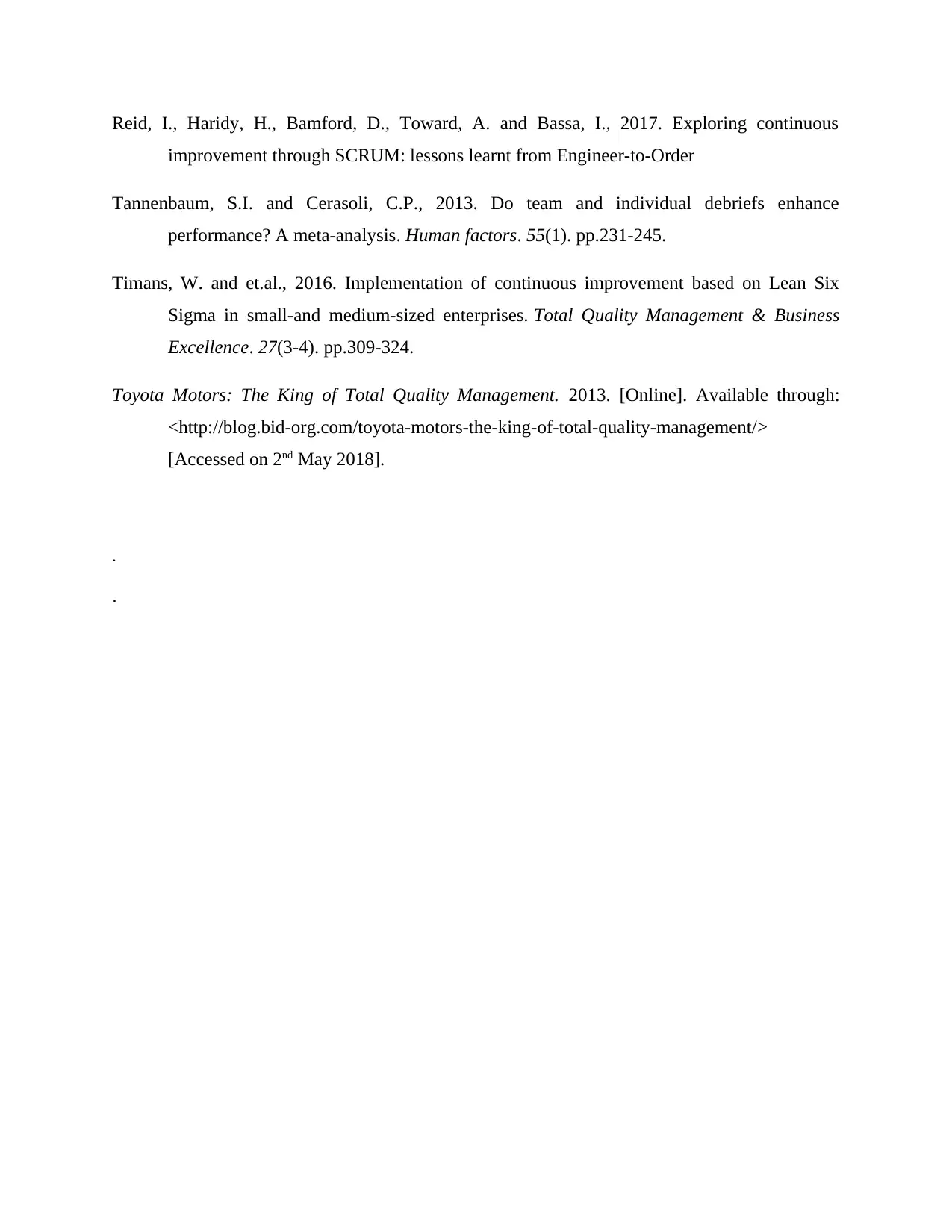
Reid, I., Haridy, H., Bamford, D., Toward, A. and Bassa, I., 2017. Exploring continuous
improvement through SCRUM: lessons learnt from Engineer-to-Order
Tannenbaum, S.I. and Cerasoli, C.P., 2013. Do team and individual debriefs enhance
performance? A meta-analysis. Human factors. 55(1). pp.231-245.
Timans, W. and et.al., 2016. Implementation of continuous improvement based on Lean Six
Sigma in small-and medium-sized enterprises. Total Quality Management & Business
Excellence. 27(3-4). pp.309-324.
Toyota Motors: The King of Total Quality Management. 2013. [Online]. Available through:
<http://blog.bid-org.com/toyota-motors-the-king-of-total-quality-management/>
[Accessed on 2nd May 2018].
.
.
improvement through SCRUM: lessons learnt from Engineer-to-Order
Tannenbaum, S.I. and Cerasoli, C.P., 2013. Do team and individual debriefs enhance
performance? A meta-analysis. Human factors. 55(1). pp.231-245.
Timans, W. and et.al., 2016. Implementation of continuous improvement based on Lean Six
Sigma in small-and medium-sized enterprises. Total Quality Management & Business
Excellence. 27(3-4). pp.309-324.
Toyota Motors: The King of Total Quality Management. 2013. [Online]. Available through:
<http://blog.bid-org.com/toyota-motors-the-king-of-total-quality-management/>
[Accessed on 2nd May 2018].
.
.
⊘ This is a preview!⊘
Do you want full access?
Subscribe today to unlock all pages.

Trusted by 1+ million students worldwide
1 out of 12
Related Documents
Your All-in-One AI-Powered Toolkit for Academic Success.
+13062052269
info@desklib.com
Available 24*7 on WhatsApp / Email
![[object Object]](/_next/static/media/star-bottom.7253800d.svg)
Unlock your academic potential
Copyright © 2020–2025 A2Z Services. All Rights Reserved. Developed and managed by ZUCOL.




